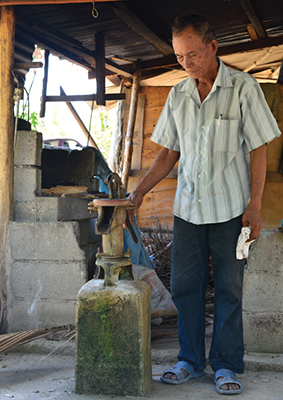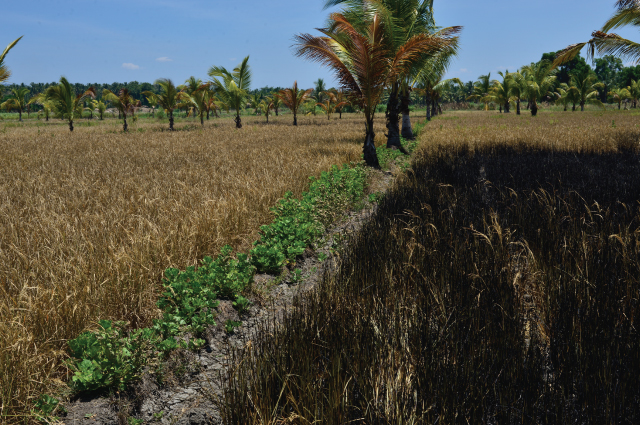“Failure.”
With those painfully heavy word, Mangansakan T. Kasan, 68, described the miserable fate of his rice crops brought by the inescapable El Niño.
Fallen yield
Kasan of Shariff Aguak, Maguindanao is one of the farmers severely affected by this natural phenomenon. At his two-hectare farm, his normal harvest of 280 bags of rice were trimmed down to 125, barely enough to pay for his debts and feed his family.
Well-aware of the prolonged dry spell, Kasan still persisted and planted munggo after harvesting his failed rice. He had high hopes to save his livelihood. Weeks after planting, however, it suffered the same fate — failure.
“Only a quarter of my munggo plants survived when the soil still had a bit moist. But worse, some of them were rat-infested,” he painfully recalled. From 150 kg of munggo on the same season last year, it dwindled to only 40 kg this time.
Green grasses turned brown, leaves were burned, grounds cracked, and seeds were mired from sprouting. This is how Kasan summed up the effects of El Niño to his agricultural land.
Heeding the call
Early this year, many provinces in Mindanao were placed under the state of calamity. The onslaught of El Niño has driven local government units and other agencies to hasten its relief efforts for farmers who experienced the same fate as Kasan. 
The regional office of the Department of Agriculture in SOCCSKSARGEN (DA-12) has reported a staggering P1.05B damage to agriculture in the region alone. Seeing the burden of this calamity to the local farmers, the office called for support for an outreach activity for farm families last April.
Line agencies of DA such as the Philippine Rice Research Institute (PhilRice) through its branch in Midsayap, North Cotabato responded to this call. PhilRice dished out 800kg of milled rice harvested from its research experimental borders. Twenty five kg of rice were also given for the relatives of each of their job contractors.
While the DA, the National Irrigation and Administration (NIA), and the Department of Social Welfare and Development (DSWD) ensured their respective roles in the plight of El Niño, others have eagerly offered assistance — the private sector, rice millers, DA employees, and even farmers.
“We assisted leaders of organized farmer cooperatives and associations in Region 12 in the distribution of rice to farm families affected by El Niño,” said Amalia J. Datukan, regional executive director of DA-12.
The dire situation of farmers especially when the bloody Kidapawan incident happened has prompted institutions and individuals to come together. Aid agencies, organized groups, and even ordinary individuals have also raised funds for farmers affected by the severe drought in Mindanao — yet another testament of solidarity when calamity strikes the country.
Are we ready?
Long before the start of El Niño, PhilRice Midsayap has been campaigning on how to mitigate its effects.
“We gave out warnings and tips to cope with El Niño. Since rice is a water-loving plant, we advised farmers to plant crops other than rice given the water shortage,” said Dr. Sailila E. Abdula, acting branch director of PhilRice Midsayap, who resonated advisories in local radio stations.
In 2015, PhilRice Midsayap and the DSWD have forged partnership for a skills training and development on rice production for over 600 beneficiaries of the Pantawid Pamilyang Pilipino Program (4Ps).
Through this program, participants were trained to be food-sufficient and resilient more so at a time of natural calamities such as El Niño.
LGUs in many parts of Mindanao that were declared as vulnerable by PAGASA have also devised mitigation plans. But as El Niño intensified, readiness of the farmers, resilience of their crops, and the overall preparation of communities were all put into test.
With the agriculture sector at most risk, the preparations are all worth it. Nevertheless, the preparations seem not enough given the magnitude of El Niño’s impact to farmers. Then, what lessons have we learned from this?
Bracing for La Niña
As El Niño is expected to die down towards mid-year, authorities have warned of a possible La Niña to follow. In this light, farms and farmers would need a new line of defense from heavy rains and stronger typhoons.
Abdula, also a member of Regional Research and Development Coordinating Council (RRDC), sees the need to form a special task force for La Niña involving different agencies at least in the regional level.
“This task force shall identify the respective roles of each agency in facilitating campaign strategies and providing technical assistance especially for farmers in areas expected to be heavily hit by the calamity,” Abdula said.
He furthered that preparations shall start immediately. “Right now, we are already recommending flood-tolerant rice varieties such as NSIC Rc222,” he added.
Shared faith and action
Kasan and his Muslim-majority community may have lost a bountiful harvest. But despite these adversities, they haven’t lost their Islamic faith to Allah. In a solemn prayer, they whisper a wish for recovery — that their livelihood be restored, and their resilience to step up.
Our fight with natural calamities call for a multi-sectoral involvement. Regardless of one’s region, affiliation, or religion, we shall come together as a call of duty or social responsibility.
Be it El Niño, typhoons, or infestation, our farmers and agricultural workers keep a good faith in hurdling calamities — that with a good mix of information, empowerment, and participation, we all rise above these adversities.





